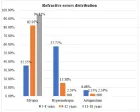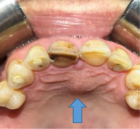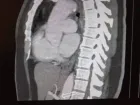Abstract
Research Article
Effect of common food additives on mast cell activation
Carena MP, Mariani ML, Ordóñez A and Penissi AB*
Published: 17 January, 2019 | Volume 3 - Issue 1 | Pages: 001-005
Mast cells play a central role in the genesis and modulation of allergic and inflammatory responses. The general aim of the present work was to study the interaction between mast cells and the most common additives approved for use in foods. Dose-response studies about the effect of the main food additives (tartrazine, sodium bisulphite and sodium benzoate) on mast cell degranulation were carried out. Rat peritoneal mast cells were incubated with: 1) buffer solution or 2) stimulus. The stimuli were tartrazine, sodium benzoate, sodium bisulphite and the calcium ionophore A23187. A23187 was used as a reference mast cell secretagogue. Different doses and combinations of food additives were used. The viability of the mast cells was evaluated with trypan blue. In the incubation solutions, the release of β-hexosaminidase was quantified by colorimetric reaction and ELISA plate reader. The remaining β-hexosaminidase concentration (not released) was studied in the cells after the incubations, and morphology of the mast cells was analyzed by light microscopy with toluidine blue stain. The food additives tartrazine, sodium benzoate and sodium bisulphite did not stimulate the release of β-hexosaminidase from mast cells at any of the concentrations used. In contrast, tartrazine at concentrations of 0.1 μM and 1 μM, and sodium benzoate and sodium bisulphite at concentrations of 0.1 μM, 1 μM, 10 μM and 100 μM, significantly inhibited the basal release of β-hexosaminidase from mast cells. Considering these findings, we decided to determine the effect of these additives on the degranulation of mast cells induced by the calcium ionophore A23187. Sodium bisulphite inhibited mast cell activation induced by the calcium ionophore A23187 in this experimental model. The present study demonstrates that food additives of usual permitted use do not stimulate basal degranulation of mast cells in an in vitro model of peritoneal mast cells and that the additive sodium bisulphite inhibit mast cell activation induced by intracellular calcium increase. This food additive could represent an interesting alternative in the prevention of pathologies mediated by mast cells, as well as in the field of nutritional biochemistry.
Read Full Article HTML DOI: 10.29328/journal.icci.1001007 Cite this Article Read Full Article PDF
References
- Galli SJ, Grimbaldeston M, Tsai M. Immunomodulatory mast cells: negative, as well as positive, regulators of immunity. Nature. 2008; 8: 478-486. Ref.: https://goo.gl/iKFxPo
- Kawakami T, Ando T, Kimura M, Wilson BS, Kawakami Y. Mast cells in atopic dermatitis. Curr Opin Immunol. 2009; 21: 666-678. Ref.: https://goo.gl/YwzDmq
- Hofmann AM, Abraham SN. New roles for mast cells in modulating allergic reactions and immunity against pathogens. Curr Opin Immunol. 2009; 21: 679-686. Ref.: https://goo.gl/PbjQjp
- Stone KD, Prussin C, Metcalfe DD. IgE, mast cells, basophils, and eosinophils. J Allergy Clin Immunol. 2010; 125: S73-S80. Ref.: https://goo.gl/CoLbdp
- Freedman BJ. Asthma induced by sulphur dioxide, benzoate and tartrazine contained in orange drinks. Clin Allergy. 1977; 7: 407-415. Ref.: https://goo.gl/kbn8zq
- Safford RJ, Goodwin BF. The effect of tartrazine on histamine release from rat peritoneal mast cells. Int J Immunopharmacol. 1984; 6: 233-240. Ref.: https://goo.gl/3rKhE1
- Collado CR, Hochman DJ, Goldblum RM, Brooks EG. Effect of sodium sulfite on mast cell degranulation and oxidant stress. Ann Allergy Asthma Immunol. 2006; 96: 550-556. Ref.: https://goo.gl/UT2xeR
- Lai MD, Xu YH. Effects of bisulphite and sulfite on Fc and Con A receptors of rat pulmonary macrophages. Chin Med J.1988; 101:357-360. Ref.: https://goo.gl/n15rbN
- Maeda-Yamamoto M1, Ema K, Monobe M, Tokuda Y, Tachibana H. Epicatechin-3-O-(3″-O-methyl)-gallate Content in Various Tea Cultivars (Camellia sinensis L.) and Its in Vitro Inhibitory Effect on Histamine Release. J Agric Food Chem. 2012; 60: 2165-2170. Ref.: https://goo.gl/nbDrLh
Figures:
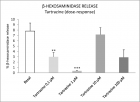
Figure 1
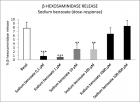
Figure 2
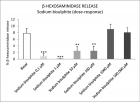
Figure 3
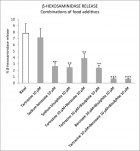
Figure 4
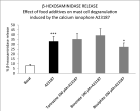
Figure 5

Figure 6
Similar Articles
-
Dendritic cells and TNF-Related apoptosis inducing ligand (TRAIL) represent new possibilities for sepsis treatmentPetya Ganova,Lyudmila Belenska-Todorova,Nina Ivanovska*. Dendritic cells and TNF-Related apoptosis inducing ligand (TRAIL) represent new possibilities for sepsis treatment. . 2017 doi: 10.29328/journal.hcci.1001001; 1: 001-004
-
Brain response in some systemic immune condition-Toxicological aspectsLuisetto M*. Brain response in some systemic immune condition-Toxicological aspects. . 2017 doi: 10.29328/journal.icci.1001002; 1: 005-008
-
The Immunitary role in chronic prostatitis and growth factors as promoter of BPHMauro luisetto*,Behzad Nili-Ahmadabadi,Ghulam Rasool Mashori,Ram Kumar Sahu,Farhan Ahmad Khan,Cabianca luca,Heba Nasser. The Immunitary role in chronic prostatitis and growth factors as promoter of BPH. . 2018 doi: 10.29328/journal.icci.1001003; 2: 001-013
-
Expression of C-type Natriuretic Peptide and its Specific Guanylyl Cyclase-Coupled Receptor in Pig Ovarian Granulosa CellsSoo Mi Kim,Suhn Hee Kim,Kyung Woo Cho,Sun Young Kim,Sung Zoo Kim*. Expression of C-type Natriuretic Peptide and its Specific Guanylyl Cyclase-Coupled Receptor in Pig Ovarian Granulosa Cells. . 2018 doi: 10.29328/journal.icci.1001004; 2: 014-025
-
Endogenous Ligands of Toll Like Receptors: A Danger Signal to the Brain Memory at High AltitudeKP Mishra*,Shashi Bala Singh. Endogenous Ligands of Toll Like Receptors: A Danger Signal to the Brain Memory at High Altitude. . 2018 doi: 10.29328/journal.icci.1001005; 2: 026-027
-
Differentiation of bone marrow cells in arthritic mice with decreased complement activityPetya Ganova,Nina Ivanovska*. Differentiation of bone marrow cells in arthritic mice with decreased complement activity. . 2018 doi: 10.29328/journal.icci.1001006; 2: 028-038
-
Effect of common food additives on mast cell activationCarena MP,Mariani ML,Ordóñez A,Penissi AB*. Effect of common food additives on mast cell activation. . 2019 doi: 10.29328/journal.icci.1001007; 3: 001-005
-
Association of Toll-like receptor 2, 4, and 9 gene polymorphism with high altitude induced thrombosis patients in Indian populationSwati Sharma,Iti Garg*,Gauri Mishra,Babita Kumari,Lilly Ganju,Bhuvnesh Kumar. Association of Toll-like receptor 2, 4, and 9 gene polymorphism with high altitude induced thrombosis patients in Indian population. . 2019 doi: 10.29328/journal.icci.1001008; 3: 006-015
-
Altitude sickness and Antarctic polar plateau: A reviewKP Mishra*,Shashi Bala Singh. Altitude sickness and Antarctic polar plateau: A review. . 2019 doi: 10.29328/journal.icci.1001009; 3: 016-018
-
Proposal for the elimination of allergiesJames F Walles*. Proposal for the elimination of allergies. . 2019 doi: 10.29328/journal.icci.1001010; 3: 019-019
Recently Viewed
-
COVID-19, Long COVID, and Gastrointestinal Neoplasms: Exploring the Impact of Gut Microbiota and Oncogenic InteractionsAmália Cinthia Meneses do Rêgo,Irami Araújo-Filho*. COVID-19, Long COVID, and Gastrointestinal Neoplasms: Exploring the Impact of Gut Microbiota and Oncogenic Interactions. Arch Cancer Sci Ther. 2024: doi: 10.29328/journal.acst.1001045; 8: 054-062
-
The Police Power of the National Health Surveillance Agency – ANVISADimas Augusto da Silva*,Rafaela Marinho da Silva. The Police Power of the National Health Surveillance Agency – ANVISA. Arch Cancer Sci Ther. 2024: doi: 10.29328/journal.acst.1001046; 8: 063-076
-
A Rare Consanguineous Case of Alazami Syndrome in a Jordanian Family: Clinical Presentation, Genetic Analysis, and Therapeutic Approaches - A Case ReportFawzi Irshaid*, Salim Alawneh, Qasim Al Souhail, Aisha Alshdefat, Bashar Irshaid, Ahmed Irshaid. A Rare Consanguineous Case of Alazami Syndrome in a Jordanian Family: Clinical Presentation, Genetic Analysis, and Therapeutic Approaches - A Case Report. J Clin Med Exp Images. 2024: doi: 10.29328/journal.jcmei.1001031; 8: 003-006
-
Hygiene and Care Protocols for Implant-supported Dental Prostheses in Patients with DiabetesHakob Khachatryan, Emma Boshnaghyan, Sevak Papoyan, Gagik Hakobyan*. Hygiene and Care Protocols for Implant-supported Dental Prostheses in Patients with Diabetes. J Oral Health Craniofac Sci. 2024: doi: 10.29328/journal.johcs.1001047; 9: 009-014
-
Impact of Latex Sensitization on Asthma and Rhinitis Progression: A Study at Abidjan-Cocody University Hospital - Côte d’Ivoire (Progression of Asthma and Rhinitis related to Latex Sensitization)Dasse Sery Romuald*, KL Siransy, N Koffi, RO Yeboah, EK Nguessan, HA Adou, VP Goran-Kouacou, AU Assi, JY Seri, S Moussa, D Oura, CL Memel, H Koya, E Atoukoula. Impact of Latex Sensitization on Asthma and Rhinitis Progression: A Study at Abidjan-Cocody University Hospital - Côte d’Ivoire (Progression of Asthma and Rhinitis related to Latex Sensitization). Arch Asthma Allergy Immunol. 2024: doi: 10.29328/journal.aaai.1001035; 8: 007-012
Most Viewed
-
Impact of Latex Sensitization on Asthma and Rhinitis Progression: A Study at Abidjan-Cocody University Hospital - Côte d’Ivoire (Progression of Asthma and Rhinitis related to Latex Sensitization)Dasse Sery Romuald*, KL Siransy, N Koffi, RO Yeboah, EK Nguessan, HA Adou, VP Goran-Kouacou, AU Assi, JY Seri, S Moussa, D Oura, CL Memel, H Koya, E Atoukoula. Impact of Latex Sensitization on Asthma and Rhinitis Progression: A Study at Abidjan-Cocody University Hospital - Côte d’Ivoire (Progression of Asthma and Rhinitis related to Latex Sensitization). Arch Asthma Allergy Immunol. 2024 doi: 10.29328/journal.aaai.1001035; 8: 007-012
-
Causal Link between Human Blood Metabolites and Asthma: An Investigation Using Mendelian RandomizationYong-Qing Zhu, Xiao-Yan Meng, Jing-Hua Yang*. Causal Link between Human Blood Metabolites and Asthma: An Investigation Using Mendelian Randomization. Arch Asthma Allergy Immunol. 2023 doi: 10.29328/journal.aaai.1001032; 7: 012-022
-
An algorithm to safely manage oral food challenge in an office-based setting for children with multiple food allergiesNathalie Cottel,Aïcha Dieme,Véronique Orcel,Yannick Chantran,Mélisande Bourgoin-Heck,Jocelyne Just. An algorithm to safely manage oral food challenge in an office-based setting for children with multiple food allergies. Arch Asthma Allergy Immunol. 2021 doi: 10.29328/journal.aaai.1001027; 5: 030-037
-
Snow white: an allergic girl?Oreste Vittore Brenna*. Snow white: an allergic girl?. Arch Asthma Allergy Immunol. 2022 doi: 10.29328/journal.aaai.1001029; 6: 001-002
-
Cytokine intoxication as a model of cell apoptosis and predict of schizophrenia - like affective disordersElena Viktorovna Drozdova*. Cytokine intoxication as a model of cell apoptosis and predict of schizophrenia - like affective disorders. Arch Asthma Allergy Immunol. 2021 doi: 10.29328/journal.aaai.1001028; 5: 038-040

If you are already a member of our network and need to keep track of any developments regarding a question you have already submitted, click "take me to my Query."







